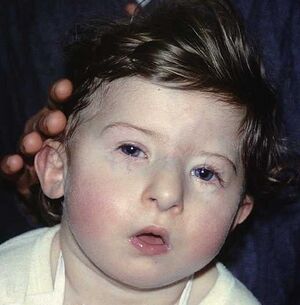Developmental defects of the branchial region
The branchial region'is the region formed by the gill structures. These structures are only temporary and are rebuilt, adapted or disappear over time. Among the most prominent structures of the branchial region are the pharyngeal (gill) arches (arcus branchiales). Pharyngeal arches arise from paired bands of ectomesenchyme in the embryonic period during the 4th to 5th week. With its development, it also creates other structures - slits, protrusions and membranes. Their influence is important for the development of the neck and face.
Developmental defects[edit | edit source]
Cleft defects[edit | edit source]
Developmental defects of the branchial region include various types of cleft defects:
- incomplete cleft lip;
- bilateral cleft lip;
- cleft lip, upper jaw and palate;
- isolated cleft palate;
- oblique facial cleft.
Lateral branchial cysts and fistulas[edit | edit source]
They are a remnant of the "sinus cervicalis", most often under the lower jaw.
Internal jugular fistula[edit | edit source]
They arise as remnants of the 3rd and 4th pharyngeal depressions in the area before the m. sternocleidomastoid.
Treacher-Collins Syndrome[edit | edit source]
This is a developmental disorder of the 1st gill arch. Cheek hypoplasia occurs due to an insufficiently formed os zygomaticum. Other disorders include hypoplasia of the lower jaw, drooping eyelids and malformations of the external ear.
Pierre Robin Syndrome[edit | edit source]
It is caused by a developmental disorder of the 1st gill arch accompanied by a cleft palate and a sunken tongue (so-called micrognathia).
DiGeorge syndrome[edit | edit source]
It is among the most serious malformations in the branchial region. There are developmental defects in the floor of the outflow system of the heart and the outflow tract of the face. The cause of this disorder can be excessive use of vitamin A, alcohol or gestational diabetes.
Goldenhav Syndrome[edit | edit source]
The main features of the malformation include a protruding forehead, hypoplasia of one side of the face, disorders of the development of the auricle and the auditory pathway, or vertebral anomalies.
Related Articles[edit | edit source]
- Development of the pharyngeal apparatus
- Facial Clefts
- Fissural cysts
- Craniofacial syndromes
- DiGeorge Syndrome
- Goldenhar Syndrome
References[edit | edit source]
- SADLER, Thomas, W and MD SINHA. Langman's Medical Embryology. 1st Czech edition. Prague: Grada, 2011. 414 pp. ISBN 978-80-247-2640-3 .
- MEŠŘÁK, Jan, et al. Introduction to plastic surgery. 1st edition. Prague: Charles University in Prague - Karolinum Publishing House, 2005. 125 pp. ISBN 80-246-1150-3 .

